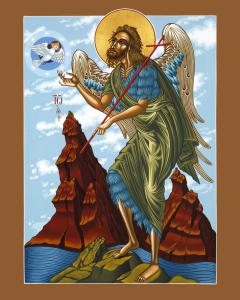Sale on canvas prints! Use code ABCXYZ at checkout for a special discount!

St John the Forerunner :
Feast of the Beheading of St. John the Baptist 29 August
So many powerful, spiritual and artistic images of John the Baptist swirl around me today on the feast of his martyrdom. John's two feasts begin and end the season of summer. I think of all the Gospel accounts of the Evangelists, and Blessed Anne Catherine Emmerich's beautiful visions of John woven within her Life of Christ, scripture scholar Joan Taylor's excellent and instructive book "The Immerser : John the Baptist Within Second Temple Judaism", Michael Damaskino's gaunt and majestic 16th century Greek icon which is the prototype for this icon, Andrea del Verrocchio's very, very tender and youthful John in his 15th century bust in the Washington DC National Gallery, Pasolini and Zefferelli's John in film, Ken Russell's radiantly pure John in "Salome" surrounded by the utter decadence of Herod's court, Emmy Lou Harris' literally moving, inspired version of Bill Monroe's song "Get Up John", and the still haunting, tragic pictures of the recent death of Catholic journalist James Foley.
On The feast of the birth of John, June 24 1981, it is believed that the Mother of God began appearing in the once tiny village of Medjugorje, in Bosnia. This is not yet approved by the church officially because the apparitions are still happening and is still quite controversial. On June 26 two days later, Mary appeared weeping and begging for prayers, asking to be called the Queen of Peace. It was ten years to the day when the wars in Bosnia would begin. You rarely hear from the pilgrims who come back from Medjugorje that Mostar is only 17 miles away. Mostar was hit harder than Sarajevo during the war, much of the city was destroyed. There were so many deaths that open parks had to be converted to cemeteries.
This icon is part of a diptych which was commissioned by Fr Svetozar , one of the Friars who lived at that time, in Medjugorje, the other panel is Our Lady of Medjugorje : the Burning Bush. By appearing on John 's feast Mary is saying she is the prophet of the Second Advent or the New Advent as St John Paul II proclaimed these times to be, in his first encyclical Redemptor Hominis. Why Medjugorje? One explanation is that the Croatian people , as well as the Friars, have always remained faithful to the Gospel of Jesus Christ and have resisted amidst martyrdom and persecution for centuries, becoming secularized. And they obviously (if you have experienced them) hold onto something of the Baptist's immersion ...when the young (at the time) visionaries asked the Mother of God " who is the holiest person in the village " she pointed to a Muslim woman and told them all religions are from God and you are not a Christian if you do not respect other true religions. Of course this does not mean cults.
John the Baptist was willing to baptize anyone with a humble interior disposition. But you had to come to him already humbled, ready to change, aware that you were a sinner, empty and hungering for God; not self-righteous as if you deserved Baptism.
"As we have seen, in Isaiah 1:12-15, God is described as saying that Temple worship is futile as are sacrifices, prayers, and festivals. For God, is not pleased with his people because their 'hands are full of blood.' In Matthew 3:11 John states 'I immerse you in water for repentance.' If one wanted to distinguish John's immersion from any other type of immersion, one would need to link it with the reason it was necessary : repentance ...repentance was for, or going towards, inward cleansing ...the process cannot go back to front. John's immersion was not primary or initiatory, as though one were accounted righteous afterwards. This notion was precisely what he rejected outright ...John immersed after righteousness had been attained."
Joan Taylor
Let's end then, with the famous words of St Augustine about the Immerser :
"Now there are many things that can be said of John the Baptist, but let me sum it up in a nutshell,
He must increase,
I must decrease."
Fr Bill McNichols
29 August 2016